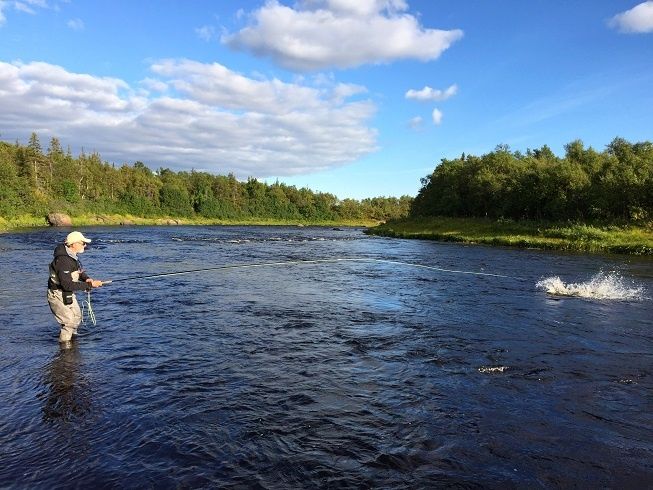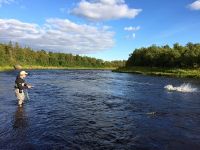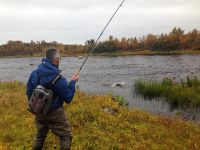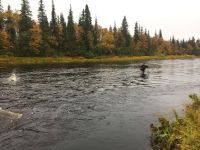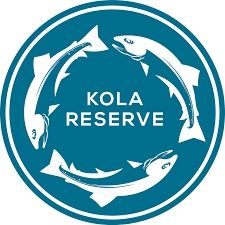This fall on the rivers of Kola Peninsula we lost an unusually large number of salmon. Two fish out of three went off the hook. We have already discussed salmon behaviour, but I want to draw your attention to the tactics of fighting salmon, on aspects that, in my opinion, could lead to loss of fish. I will focus only on regular situations often occurring and will not consider all possible options. Just want to say that we do not use boats or guides with giant nets, patiently waiting for the fish in the centre of the river. Our philosophy is somewhat different. Fisherman has the right to get the full amount of pleasure from the fight with salmon. Fish is considered landed if the angler could bring it to the shore by himself. The guide grabs the salmon only when the fish is fixed.
The outcome of the fight between the fisherman and the salmon is influenced by:
1. The nature of the river - first of all its strength of the current. Here pure physics apply. It is necessary as soon as possible to remove the fish from the main stream. I have witnessed many times like already unconscious salmon kept bending the rod of the same exhausted angler. Fight with the current - lose of time and lose of fish. A fishing line is torn, hooks are unbent, damaged fish.
2. Position of the salmon and fisherman. Sometimes we need to improve our position very quickly with respect to the moving fish. The worst situation is when the fish took a fly below you along the river. As a rule, it rushes away from you down the river. The further the fish go downstream, the greater our chances of losing it. Its important to move to the shore and downstream with respect to the position of the fish.
3. Here, much depends on the ability of the fisherman to move around the river. Ability of an angler to improve his position for fighting salmon depends primarily on his physical condition and of course from the strength of the current and the character of the bottom. Try to go ashore. The best position for the fight is to stand on the bank of the river below the fish downstream. Now the current is working for you, and your fishing tackle is safe.
4. The size of the fish and your fishing tackle. Often, large fish cause problems when we are not psychologically ready to meet with it. Fish of medium size can dull our attention and provoke mistakes when a really large salmon is on the hook. In general, we lose such a fish in the Autumn in the low water conditions, when we try to stop the running fish or use to much power fighting it. The length of the rod is not so important. Here you can see both advantages and disadvantages at the same time. When fighting salmon on long distance, it seems to be more convenient to use a two-handed fishing rod, but it's more convenient to work with a short rod at a short distance or at the shore. The power of the rod is also secondary and does not directly affect the duration of the fight. What's important is strength of the tippet, your landing skills and also strength of your arm.
Now you can summarize what has been said and highlight the most important thing. Do not fight with fish in unfavorable conditions. Until you have taken a position closer to the shore and below the fish downstream, do not try to force events. Absolute majority of fish go off the hook when we try to drag fish against the current. If the fish can use the force of the current against you, you can not control the tension of the line and the salmon will always have a chance to get off the hook. Begin to use your power only after taking the correct position. The only exception is the situation when salmon simply run downstream towards fast rapids.
The fight itself should not look like trying to lift a fish into the air or aimlessly hold it against the current. The fish should be pulled to the shore. We tilt the rod and pull the fish downstream and definitely! to the shore. Salmon can try to go upstream or downstream. We have to change the position and start everything from the beginning.
There are 2 reasonable options for accomplishing our efforts. If at our feet the fish moved downstream, sharply carry the rod after it and turn the head of the salmon to the shore. If the fish tries to go up, move the rod up and to the side and also strengthen the draft as much as possible perpendicular to the shore. Sometimes, a skillful change in the direction of traction of the rod leads to the fact that the fish accelerating itself right to the shore.
In any case, try to use the force of the current and the energy of salmon movement for your own advantage, whenever possible. This will reduce the load on the tackle, cause less damage to the fish and reduce the time of the fight.


